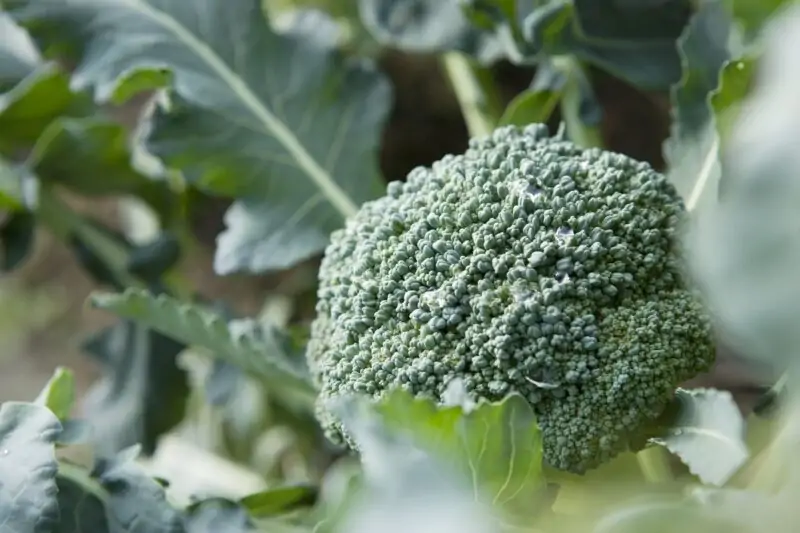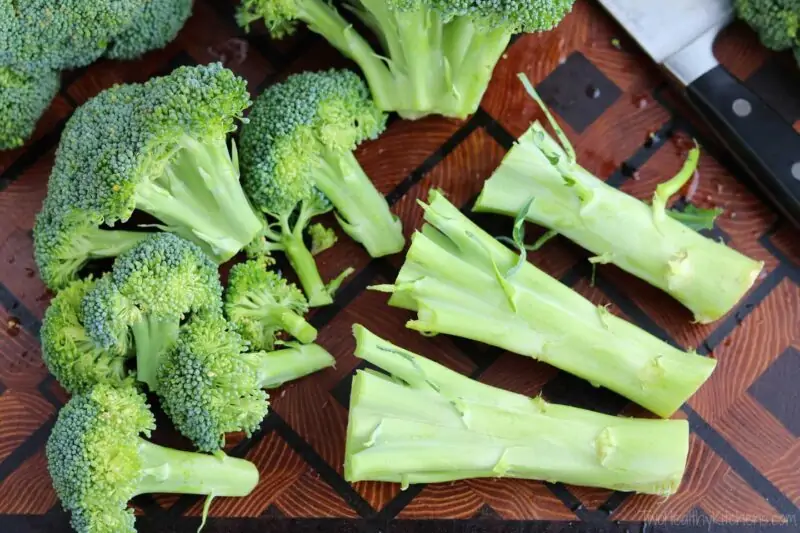How to Grow Broccoli from Stem, Scraps and Seeds

If you’re a broccoli lover, you know how important it is to have the freshest and most nutritious broccoli possible. And what’s more fresh and nutritious than growing your own? In this beginner’s guide, you’ll learn how to grow broccoli from stem pieces or scraps! Growing broccoli at home is easier than you might think, and it can be done with just a few simple steps!
How to Grow Broccoli from Stem
Growing broccoli from stem pieces is one of the easiest ways to start your journey towards homegrown veggies. Here are four easy steps that will take you from start to finish:
1. Preparing the Broccoli Stem
To prepare the broccoli stem for planting, cut off any florets or leaves until only about two inches remain. Then, using a sharp knife, slice the remaining stalk in half lengthwise.
2. Rooting the Stem in Water
Next, place your sliced stem into a jar or glass filled with water. Make sure the cut side is facing down. Ensure no leaves are submerged in water as they can rot easily. You’ll want to change the water every couple of days to keep it fresh and oxygenated.
After about five days, new roots should begin forming at the base of your stem piece – congratulations!
3. Setting Up the Planting Area
Now it’s time to set up your planting area! Choose an area that gets plenty of sunlight (at least six hours per day) and has good drainage since broccoli doesn’t like wet feet. Add compost or organic fertilizer if needed before planting.
Broccoli likes fertile soil rich in nitrogen, but make sure not to add too much. Too much nitrogen may result in stunted growth and produce smaller heads instead of large ones!
4. Transplanting the Rooted Stem
Once your stem piece has grown a few inches of roots, it’s time to transplant it! Choose an area in your garden that gets plenty of sunlight and add some compost or organic fertilizer if needed. Gently remove the stem from the water jar and plant it in soil so that only the top half is above ground level.
Water regularly (but not too much!) and keep an eye on pests like aphids or cabbage worms. Broccoli likes temperatures between 60-65°F, so make sure you’re planting at the right season!
Growing Broccoli from Scraps

If you don’t have any broccoli stems handy but still want to grow your own veggies, don’t worry – you can also grow broccoli from scraps! Here are two easy steps for growing broccoli from kitchen waste:
1. Choosing the Right Scraps
Choose broccoli scraps with about one inch of stalk attached, including leaves and florets. The fresher the scrap, the better chance it will root and sprout properly.
2. Caring for Broccoli Grown from Scraps
Once you’ve chosen your perfect scraps, place them on a windowsill where they’ll get plenty of indirect light while rooting in water-filled jars or glasses. Change out their water every couple days to keep it fresh and oxygenated.
After about five days, new roots should begin forming at the base of each scrap – isn’t this exciting? Once those babies start sprouting, transplant them outdoors into fertile soil rich in nitrogen as described earlier.
Growing Broccoli from Seeds
If you want to start a broccoli garden, growing it from seeds is the most rewarding option. Not only will you have control over the plant’s growth and development, but this method also allows for a greater variety of choices when it comes to selecting your plant. Here’s what you need to know about starting your own broccoli plants from seed.
1. Seed Selection and Preparation
The first step in growing broccoli from seeds is choosing the right ones. You’ll find many different varieties available at gardening stores or online shops. Choose one that suits your climate and soil type, depending on whether you are planning an indoor or outdoor garden.
Before planting any seed, make sure they’re healthy. Check their expiry date (if there is one) and their color. Brownish-colored seeds won’t germinate well compared to fresh greenish ones.
Once you have selected the best-quality seeds possible, it’s time to prepare them for planting. To do so, soak them in lukewarm water overnight before sowing them in loose potting mix or directly into garden beds with good drainage.
2. Planting and Germination
When sowing seeds indoors, fill small containers halfway with potting mix. Then sprinkle seeds about two inches apart in each container. Cover lightly with additional potting mix and mist thoroughly using a spray bottle until the soil is moistened.
Next, wait patiently for germination! This process should take between five days to two weeks. The warmer the environment around your seedlings, the quicker they’ll grow roots and sprout leaves.
Ensure that young plants receive adequate sunlight daily—about 6-8 hours—by placing them on a sunny windowsill or using grow lights. Keep the soil moist but not over-watered, as this can lead to root rot.
3. Transplanting Seedlings
When your seedlings have grown large enough (around four inches tall), it’s time to transplant them. Make sure the plants are healthy and sturdy before moving them. If they appear weak or spindly, wait until they’re stronger and better able to handle transplantation stress.
After transferring the plants outside, ensure they receive plenty of water. Be mindful not to “drown” them with too much liquid at once. Instead, let their roots settle in gradually by watering gently yet consistently throughout each day for several days.
Congratulations! You’ve successfully propagated broccoli from seeds, which is an achievement worth celebrating!
Harvesting and Enjoying Your Broccoli
1. Signs of a Mature Broccoli Plant
Broccoli needs around three months from planting till harvest season. Once you see the plant growing vigorous leaves and stalks reaching up about eighteen inches long, you’ll know it’s almost ready for harvest. Look out for small yellow flowers that signal maturity. These will soon develop into green heads full of nutritious florets.
Keep monitoring your plant regularly. Don’t miss its prime harvesting window. Waiting too long can cause buds to open up into tiny yellow flowers prematurely, lowering overall yield.
2. Harvesting Techniques
To reap the benefits of fresh homegrown broccoli, use sharp scissors or a knife to cut off each head. Cut just below where it attaches to the main stem. This technique encourages side shoots formation, resulting in multiple smaller heads forming after cutting big ones off.
Make sure to harvest each head before the florets start blooming, which is usually around 6-12 inches in diameter. Don’t wait too long or you’ll end up with tough and bitter broccoli that’s hard to eat.
3. Storing and Using Your Homegrown Broccoli
After harvesting your home-grown broccoli heads, store them properly so they last longer. To do this, rinse the heads under cold running water. Shake off any excess moisture before wrapping in a dry paper towel or cloth. This will keep them fresh for at least five days when stored in the refrigerator crisper drawer.
Broccoli can be enjoyed cooked or raw: add it as a side dish to grilled meals, mix into salads for added nutrition, or puree it into soups for an extra boost of flavor!
With proper care and attention, you can regrow broccoli and enjoy multiple harvests. By following these steps, you’ll be well on your way to having a bountiful and nutrient-dense veggie garden. Keep an eye out for pests and diseases, and use a spray bottle to mist your plants if needed. Remember to provide your broccoli plants with at least 6-8 hours of direct sunlight each day and maintain proper humidity levels indoors.
Tips for a Successful Broccoli Garden
Growing broccoli in your garden is fun and rewarding. It’s a fantastic way to add fresh, nutritious veggies to your meals. However, like other plants, broccoli has specific requirements to thrive. Here are some tips on growing healthy and productive broccoli plants.
1. Light and Temperature Requirements
Broccoli is a cool-season crop. It grows best in temperatures between 60°F and 65°F (15°C to 18°C). It needs at least six hours of sunlight daily. This makes it suitable for planting during fall or early spring.
If you live in an area with hot summers, consider providing shade. This protects the plants from scorching. If frost occurs before harvest, cover the plants with blankets. This ensures they survive until maturity.
2. Soil and Fertilizer Recommendations
Broccoli prefers slightly acidic soil with a pH of 6.0-7.5. Before planting, ensure the soil is fertile and well-draining. Amend it with compost or aged manure.
Fertilize regularly throughout the growing season. Use nitrogen-rich fertilizers, like blood meal or fish emulsion. Apply every three weeks. Over-fertilizing can lead to excessive leaf growth at the expense of floret development.
3. Watering and Humidity Considerations
Consistent watering is the key to success. Provide enough water to keep the soil moist but not waterlogged. Avoid letting it dry out completely between watering sessions.
To prevent moisture-related problems, use drip irrigation or a hosepipe. Aim directly at the base of each plant. Avoid overhead watering methods, which wet leaves.
Humidity levels should be around 40%-50%. Increase humidity by misting the plants with a spray bottle or placing a tray of water near the garden.
4. Pest and Disease Management
Broccoli is susceptible to pests like aphids, cabbage worms, and slugs. These can cause significant damage if not controlled early.
To control pests, use organic methods like companion planting with marigolds. These release natural insect repellents. You can also handpick pests off the plants.
Diseases like clubroot, rot, and downy mildew can affect broccoli. Proper care practices like crop rotation and soil sterilization help prevent diseases.
Frequently Asked Questions
Yes! Regrow broccoli from its stem by cutting off the bottom third of the stalk (including leaves). Submerge it halfway into water until new roots sprout. Then transplant into soil for growing again!
Both options are good choices. However, starting from seeds gives you more control over plant quality.
On average, one healthy mature plant produces one to two pounds of florets per season.
There are several types of broccolis, including Calabrese Broccoli, Sprouting Broccoli, and Romanesco Broccoli.
The ideal time for growing broccoli depends on your location. Fall-spring is best for regions with cool or mild weather. Summer planting is best in areas with less harsh summers.
Yes! Broccoli can grow in containers with a minimum depth of 18 inches and enough drainage holes.
Conclusion
Growing broccoli at home allows you to enjoy the taste of fresh and nutrient-dense vegetables straight from your backyard. By following these tips for successful broccoli gardening, you’ll be well on your way to a fantastic harvest. Don’t forget to consider light and temperature requirements, soil and fertilizer recommendations, watering and humidity considerations, pest and disease management, as well as frequently asked questions such as regrowing broccoli from stalks or growing it in pots.
By taking the time to understand and cater to broccoli’s specific needs, you’ll soon reap the rewards of your hard work. Broccoli is quite a nutrient-dense veggie, and you’ll be proud to serve it to your friends and family.
As a gardener, remember that patience is key. Broccoli needs time to grow, and it may take weeks before the last frost date. But, with dedication and perseverance, you’ll soon find yourself with a large head of broccoli, ready to harvest and enjoy.
Whether you’re planting broccoli seeds or regrowing stems, the process of nurturing your own broccoli plants can be a gratifying experience. We hope you find this article helpful as you start preparing your garden for the season.
Happy gardening, and enjoy your homegrown broccoli!